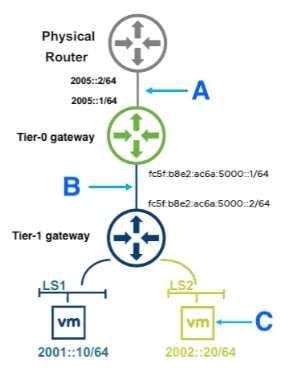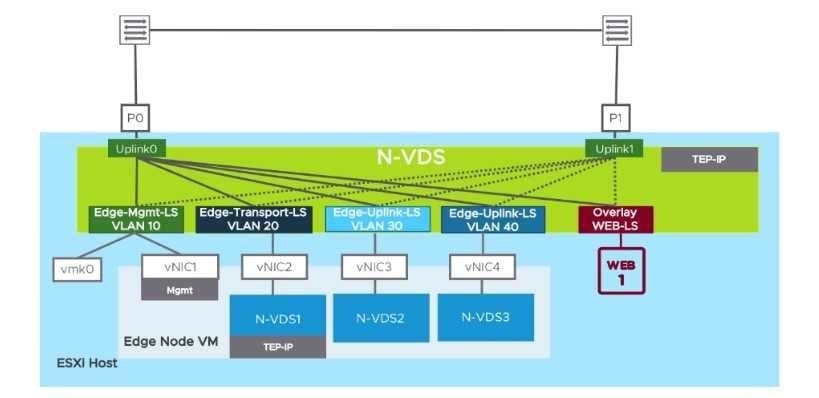3V0-41.19 Online Practice Questions and Answers
Which three must be taken into consideration when creating a Logical Design for a planned migration? (Choose three.)
A. A transport node can attach single VLAN transport zones with single N-VDS.
B. An N-VDS with the same name can be attached to both Overlay and VLAN transport zones.
C. An N-VDS can attach to both an Overlay and a VLAN transport zone to a N-VDS having different name/s.
D. An N-VDS can only attach to a single Overlay transport zone.
E. An N-VDS can only attach to a single VLAN transport zone.
F. An N-VDS can only attach to a multiple VLAN transport nodes.
An architect is helping an organization with the Logical Design of an NSX-T Data Center solution. This information was gathered during the Assessment Phase:
1.
Customer currently has a single 10 host vSphere cluster.
2.
Customer wants to improve network security and automation.
3.
Current cluster utilization and business policies prevent changing the existing vSphere deployment.
4.
High-availability is important to the customer.
Which three should the architect include in their design? (Choose three.)
A. Apply vSphere Distributed Resource Scheduler (vSphere DRS) VM-Host anti-affinity rules to NSX Managers.
B. Deploy at least two large-size NSX-T Edge virtual machines in the vSphere cluster.
C. Apply vSphere DRS VM-Host anti-affinity rules to the virtual machines of the NSX-T Edge cluster.
D. Remove 2 hosts from the cluster and create a new edge cluster.
E. Apply vSphere DRS VM-Host affinity rules to the NSX-T Controller VMs.
F. Deploy the NSX Controllers in the management cluster.
Which three are part of a Design Approach when discussing design alternatives and their effects.(Choose three.)
A. backup
B. knowledge
C. cost
D. security
E. budget
F. performance
An architect is helping an organization with the Logical Design of an NSX-T Data Center solution. This information was gathered during the Assessment Phase:
1.
On premises deployment required.
2.
Use the existing network infrastructure.
3.
ESXi hosts have 2 pNICs with only 1 available for use.
4.
High availability will be required across all ports in any proposed solution.
5.
N-VDS will be required across the infrastructure in the future.
Which should the architect include in their design?
A. Use N-VDS for management and workload traffic.
B. Use a VDS for management traffic and N-VDS- for workload traffic.
C. Use VDS for management and workload traffic.
D. Use a N-VDS for management traffic and VDS- for workload traffic.
What would an architect recommend to a customer that wants to extend management to an additional data center through Layer 2, but does not want to add additional NSX-T licensing?
A. Deploy a standalone Edge as the L2 VPN client.
B. Deploy a standalone NSX Controller.
C. Deploy a standalone NSX Manager.
D. Deploy a standalone Edge as the IPSec VPN.
Refer to exhibit: An NSX architect is creating a Greenfield NSX-T Data Center solution using IPv6 addressing. This solution will form the starting point for a migration away from IPv4 addressing in the data center.

What are three correct labels for locations A, B, and C in the exhibit? (Choose three.)
A. Static IPv4 Addresses
B. Auto assigned from fc5f:b8e2:ac6a::/48 Unique Local
C. Static IPv6 addresses
D. Auto Assigned from fe:::::/48 Unique Local
E. DHCP relay for IPv4
F. Static IPv6 addresses and DHCP Relay
An architect is helping an organization with the Logical Design of an NSX-T Data Center solution. This information was gathered during the Assessment Phase:
1.
NSX-T will span across two sites for disaster recovery.
2.
Public Load Balancer VIP should be accessible from a secondary site.
3.
Distributed Firewall Policies should be available at a secondary site.
4.
Routing capabilities should be maintained after failure.
5.
NAT capabilities are required.
Which two should the architect include in their design? (Choose two.)
A. Use IP sets or groups to configure DFW rules.
B. Use MTU to 1550 between sites.
C. Use of the same ISPs across sites.
D. Use two separate ISPs across sites.
E. Set MTU to 1500 between sites.
According to the Discover Task of the Engagement Lifecycle, which statement would be classified as a risk?
A. To retain certification to provide financial services to end customers, PCI-DSS audits need to be passed.
B. A merger and acquisition process was recently completed and new company on-boarding is not completed.
C. Due to existing contracts and purchase agreements, the existing server hardware needs to be re- used.
D. Enough power and cooling capacity is available in each rack in the data center.
Refer to Exhibit.

To meet the technical requirements for NSX Edge VM, which two design choices are required to satisfy this architectural design. (Choose two.)
A. NSX Edge TEP and ESXi TEP need to be in different VLANs.
B. ESXi host should be prepared as a Transport Node and use VLAN backend segments to connect Edge Node Interfaces.
C. ESXi host must have more than 2 pNICs available to create another N-VDS. D NSX Edge should run as a physical device.
D. vmk ports need to be on VDS instead of N-VDS, with onepNIC for each virtual switch providing greater functionality.
A customer wants to use ECMP to provide additional throughput and availability for their critical business applications. Some applications require load balancing for scale and availability. Which two Edge design choices can an architect present to the customer? (Choose two.)
A. Configure ECMP and Load Balancing on the Tier-0 gateway.
B. Create a Tier-0 gateway in Active/Standby mode and a Tier-1 gateway in Active/Standby mode.
C. Configure ECMP on the Tler-0 gateway and Load Balancing on the Tier-1 gateway.
D. Create a Tier-0 gateway in Active/Standby mode.
E. Configure ECMP on the Tier-1 gateway and Load Balancing on the Tier-1 gateway.
F. Create a Tier-0 gateway in Active/Active mode and a Tier-1 gateway in Active/Standby mode.